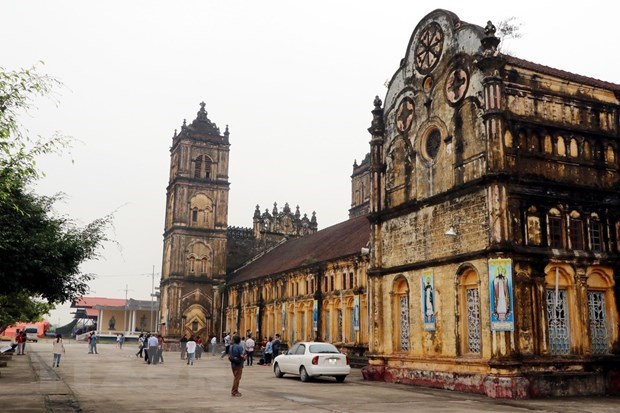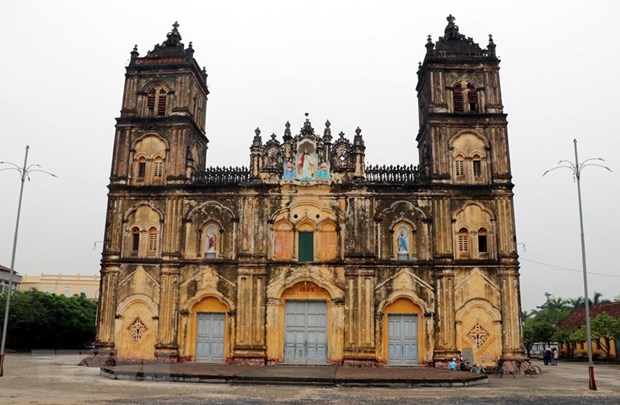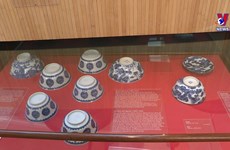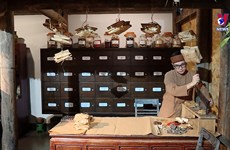Bui Chu church restoration: safety first
Hanoi (VNA) - Under whatever option the restoration will be done, the contractor must be one with expertise in the work for religious and belief constructions.
 Bui Chu church built in 1884. (Photo: VNA)
Bui Chu church built in 1884. (Photo: VNA)About the restoration of the Bui Chu church in Xuan Ngoc commune, Xuan Truong district, Nam Dinh province, Dr. Architect Hoang Dao Cuong, head of the Relic Preservation Institute under the Ministry of Culture, Sports and Tourism, held that the top priority must be given to the safety of the users (local community, religious followers, visitors, etc).
Besides, the restoration must also maintain the basic characteristics, core and typical values of the construction.
On the basis of the scientific dossiers of the church prepared by the institute in 2006, the findings of the examination of the conditions of the church (May 2019) and ideas of the sides concerned, the official proposed two options for the restoration: partial and complete (demolition of the church to the foundation).
Partial restoration
Under this option, the institute proposes keeping the scale and structure of the church while demolishing parts of construction for restoration. For the roof, the tiles in good condition will be reused to the maximum, and new ones made in the old size used to replace broken tiles. The roof will be restored with the reference to archival images taken in 1950.
The wooden frame of the church will also be demolished part by part, pillars strengthened, and totally decayed wooden parts replaced with new ones of the same types. The foundation, the bell tower and the inclining wall sections were proposed to be repaired with modern technology.
 Bui Chu Church before restoration (Photo: VNA)
Bui Chu Church before restoration (Photo: VNA)Also under this option, wall sections with cracking will be strengthened and restored in terms of both sustainability and decorative designs. All of the ceiling made from straw and lime, wood and decorated in the traditional technology will be repaired.
Cuong held that although the traces, scale and structure of the construction can be preserved under this option, the problem is the sustainability. It could stand for some time but will need to be maintained and repaired annually or periodically. “That is not to say that this option, if used, will cause relatively large losses, namely the wooden components already prepared in service of the reconstruction of the church,” he said.
Complete restoration
The second option proposed by the institute is completely demolishing the construction to the old foundation. Accordingly, the foundation system will be built with modern technology which can ensure sustainability and stability.
 The construction is suffering from many broken parts.
The construction is suffering from many broken parts.(Photo: VNA)
To avoid alien images the church may bear after the restoration, the institute has proposed to keep the old structure, scale and size (if there is any expansion, it will not be too large). Besides, it also highlights the need to keep the original altitude of the foundation, with the addition of embankments.
“Special attention should be paid to the keeping intact of the tombs of the priests, the restoration of worshipping objects, the stele erected under the Thanh Thai reign, and the two bronze bells,” the report by the institute stressed.
Besides, under this option, the core values and important original factors of the periods will be preserves, and wooden pillar bases as well as metal designs reused to the maximum.
According to Cuong, under this option, the sustainability and stability of the construction can be ensured, and basic characteristics as well as typical core values preserved. This option is feasible and can avoid material losses for religious followers.
In the document to the Ministry of Culture, Sports and Tourism concerning the options for the restoration of the Bui Chu church, the institute holds that under whatever option the restoration will be done, the contractor must be of high expertise in the work for relics and the building of religious and belief constructions. During the work, the sides concerned must make complete and detailed dossiers before the partial or complete demolition.
Regarding the proposal for the building of a new construction (for use) besides the keeping of the old church (for preservation), Cuong held that this option is irrational as it will both cause losses and waste and make the construction to be kept (for preservation purpose) fail to perform its right function (mass venue).
Previously, there were contradictory ideas on the demolition of the Bui Chu church. At the information that Bui Chu diocese will demolish the church on May 13, a group of 25 architects sent their proposal to the Prime Minister, the Minister of Culture, Sports and Tourism, and the Chairman of the People’s Committee of Nam Dinh province, asking them to keep the church.
The group held that it is a construction with many values in artistic structure and culture. The church bears in itself hallmarks of European architecture and the combination of Vietnam’s factors, details and materials to become a unique artistic work that manifests the convergence of the Western and Eastern cultures.
On May 7, the ministry sent a delegation to work with the Nam Dinh People’s Committee and to make a field inspection. Their findings were that the construction is suffering from many broken parts: front doors cracking, left tower inclining, side arches cracking, interior part downgrading, and broken parts threatening to fall at any time. The church is not only a property of the diocese but also a venue of many religion-related activities. The consideration of the reconstruction of the church must be based on the real condition of the relic.
On the basis of the report by the working group, the Minister of Culture, Sports and Tourism has assigned the institute to make assessment and propose options for the restoration of the church.
In the morning of May 10, Priest Nguyen Duc Giang, chief representative of the Bui Chu diocese signed an announcement on the postponement of the demolition of the church.
The Bui Chu church was constructed under Spanish bishop Wenceslao Onate Thuan. It was started in 1884 and completed a year later, measuring 78 m in length, 22 m in width, 15 m in height, and its tower stands 35 m tall. So far, it has experienced several repairs, including those in 1974 and 2000.-VNA












